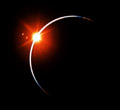
The first image of the Earth made from orbit was this badly smeared photograph made by Explorer 6 on August 14, 1959. 24K
The first television image of Earth from orbit was made by the Tiros weather satellite, on April 1, 1960. 28K
The first crude television image of the distant Earth as a planet in space was made by a Soviet weather satellite on May 30, 1966. 68K
 Earth was first shown as a disk in color by the Department
Of Defense Gravity Experiment satellite (DODGE) operating between
July and November 1967. This image was captured on September 20.
At the bottom can be seen a boom with a color target, a painted
sphere. This historic image, perhaps shown here for the first
time on the web, was kindly provided by Robert Beal of the John
Hopkins Applied Physics Lab, who painted the color ball and produced
this image. In this
version I have attempted to 'reconstruct' the colors, the
boom manually repainted with something more resembling the original
hues of the 'color ball', sadly not well conveyed with that nonetheless
pioneering imaging system. On November 16-17 the satellite tumbled
out of control, possibly from the impact of a Leonid meteor! 169K
Earth was first shown as a disk in color by the Department
Of Defense Gravity Experiment satellite (DODGE) operating between
July and November 1967. This image was captured on September 20.
At the bottom can be seen a boom with a color target, a painted
sphere. This historic image, perhaps shown here for the first
time on the web, was kindly provided by Robert Beal of the John
Hopkins Applied Physics Lab, who painted the color ball and produced
this image. In this
version I have attempted to 'reconstruct' the colors, the
boom manually repainted with something more resembling the original
hues of the 'color ball', sadly not well conveyed with that nonetheless
pioneering imaging system. On November 16-17 the satellite tumbled
out of control, possibly from the impact of a Leonid meteor! 169K
High definition color television images of the Earth as a disk were first obtained by the U.S. Applications Technology Satellite, this early example taken on November 18, 1967. I have rebalanced the color in this scan from the NASA SP 'Exploring Space With A Camera'. 352K The original color balance can be seen here.
On August 8, 1969 while on its way to the Moon, Zond 7 obtained excellent color photography of the Earth at a distance of about 70,000 km.. This seldom seen full Earth photo was digitally restored from a badly faded print. 1 MB.
During the first human journey to the Moon, Apollo 8, the three astronauts became the first to see Earth as a world in space. Among the photographs they obtained are this one showing South America nearly covered with clouds and the brown Sahara withdrawing into the night. 416K
 On
November 24, 1969 at about 17:04 GMT Apollo 12 was returning from
the second Lunar expedition, when about 3 hours and 45 minutes
before re-entry, at an altitude of 30,044 nautical miles, the
Sun was eclipsed behind the bright rim of the otherwise dark Earth.
As the Sun was eclipsed with a last vivid red afterglow the overexposed
narrow arc of the bright atmosphere nearest the Sun appeared a
bright blue, with pink colors on either side, visible here, giving
way to an all encircling blue too dim to capture on film. Only
color 16 mm movie and black & white 70 mm film were available
to capture the sight. An
attempt to merge the best of both formats is here, with visually
noted features added. (note the pair of 'Sun reflections', the
oval one on the left is from the color 16mm frame made while the
Sun was still partly visable, and the linear right reflection
from the high resolution 70mm frame shot as the Sun was at or
near being physically hidden, but strongly refracted by the atmosphere.
Nearly an hour later the crews dark adapted eyes detected additional
dim light details. Moonlit clouds as well as the Moon's reflection
from the Indian Ocean were seen, then land masses, lightning storms
and even the brightest city lights. This hour long eclipse provided
a sight unique to space exploration. 56K.
On
November 24, 1969 at about 17:04 GMT Apollo 12 was returning from
the second Lunar expedition, when about 3 hours and 45 minutes
before re-entry, at an altitude of 30,044 nautical miles, the
Sun was eclipsed behind the bright rim of the otherwise dark Earth.
As the Sun was eclipsed with a last vivid red afterglow the overexposed
narrow arc of the bright atmosphere nearest the Sun appeared a
bright blue, with pink colors on either side, visible here, giving
way to an all encircling blue too dim to capture on film. Only
color 16 mm movie and black & white 70 mm film were available
to capture the sight. An
attempt to merge the best of both formats is here, with visually
noted features added. (note the pair of 'Sun reflections', the
oval one on the left is from the color 16mm frame made while the
Sun was still partly visable, and the linear right reflection
from the high resolution 70mm frame shot as the Sun was at or
near being physically hidden, but strongly refracted by the atmosphere.
Nearly an hour later the crews dark adapted eyes detected additional
dim light details. Moonlit clouds as well as the Moon's reflection
from the Indian Ocean were seen, then land masses, lightning storms
and even the brightest city lights. This hour long eclipse provided
a sight unique to space exploration. 56K.